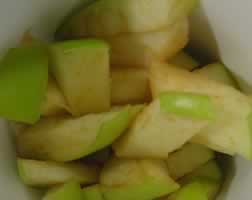Food chemistry
Antioxidants

Atmospheric oxygen creates havoc for people in the food industry. Atmospheric oxygen quickly oxidises certain substances in food causing spoilage. Additives known as antioxidants are added to the food and mop up atmospheric oxygen before it can react with particular compounds in the food.
Ascorbic acid (vitamin "C" (C6H8O6)) is used as an antioxidant. It reacts with atmospheric oxygen according to the reaction below.
2C6H8O6(aq) + O2(g) -->2C6H6O6(aq) + 2H2O(l).
Most fruit salads contain apple. When apple is sliced it quickly oxidises and turns brown. Lemon juice, which is high in vitamin C, is often used to stop the oxidation taking place.
